The Surtees Racing Organisation was a race team that spent nine seasons as a constructor in Formula One, Formula 2, and Formula 5000.
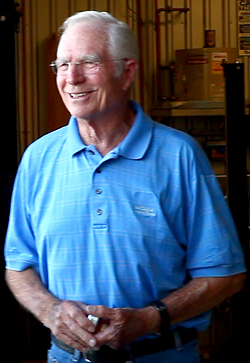
James Ellis Hall is a retired American racing driver, race car constructor, and team owner. While he is best known as a car constructor, he was one of the greatest American racing drivers of his generation, capturing consecutive United States Road Racing Championships, two Road America 500s, two Watkins Glen Grands Prix for sports cars, the 1965 Canadian Grand Prix for sports cars, the 1965 Pacific Northwest Grand Prix, and scoring a massive upset at the 1965 12 Hours of Sebring over a contingent of factory-backed Ford GTs, Shelby Daytona Coupes, and Ferrari entries. If anything Hall's accomplishments behind the wheel have been overshadowed by his pivotal contributions to race car design through his series of Chaparral sports racing and Indy cars. Hall's cars won in every series in which they competed: USRRC, Can-Am, Trans-Am, Formula 5000, World Sportscar Championship, Autoweek Championship, Canadian Sports Car Championship, and the Indianapolis 500.
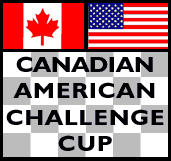
The Canadian-American Challenge Cup, or Can-Am, was an SCCA/CASC sports car racing series from 1966 to 1974, and again from 1977 to 1987.
Chaparral Cars was a pioneering American automobile racing team and race car developer that engineered, built, and raced cars from 1963 through 1970. Founded in 1962 by American Formula One racers Hap Sharp and Jim Hall, it was named after the roadrunner, a fast-running ground cuckoo also known as a chaparral bird.

A Daytona Prototype was a type of sports prototype racing car developed specifically for the Grand American Road Racing Association's Rolex Sports Car Series as their top class of car, which replaced their main prototype racing class, specifically Le Mans Prototypes (LMPs). The cars later competed in the merged series of the IMSA SportsCar Championship, from 2014 to 2016, before being phased out and replaced by the Daytona Prototype International class in 2017. They are named after the main series event, the Rolex 24 at Daytona.

The Mirage Lightweight Racing Car was a family of race cars built by J.W. Automotive Engineereing (JWAE) at Slough in England, initially to compete in international sports car races in the colours of the Gulf Oil Corporation.

The Lola T70 is a sports prototype developed by British manufacturer Lola Cars in 1965. Lola built the aluminium monocoque chassis, which were typically powered by large American V8s.
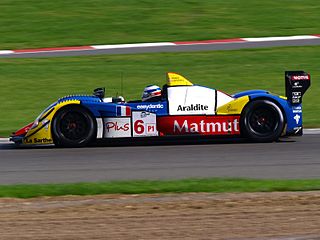
Courage Compétition was a racing team and chassis constructor company now owned by Oreca, based in Le Mans, France, near the Circuit de la Sarthe. It was founded by Yves Courage, a French race driver who ran hillclimbs before founding the company. Following the purchase of Courage by Oreca in 2007, Yves Courage has refounded the company as Courage Technology in 2010, attempting to develop electric racing cars.

The McLaren F1 GTR is the racing variant of the McLaren F1 sports car first produced in 1995 for grand touring style racing, such as the BPR Global GT Series, FIA GT Championship, JGTC, and British GT Championship. It was powered by the naturally aspirated BMW S70/2 V12 engine. It is most famous for its overall victory at the 1995 24 Hours of Le Mans where it won against faster purpose-built prototypes in very wet conditions. The F1 GTR raced internationally until 2005 when the final race chassis was retired.
Eric Harrison Broadley MBE was a British entrepreneur, engineer, and founder and chief designer of Lola Cars, the motor racing manufacturer and engineering company. He was arguably one of the most influential automobile designers of the post-war period, and over the years Lola was involved with many high-profile projects in Formula One, IndyCar, and sports car racing. Broadley sold Lola to Martin Birrane in 1997.

The BMW V12 LM was a racing car built for sports car racing in 1998. The car was built using a combination of WilliamsF1 chassis engineering and construction and a BMW powerplant. The car was a predecessor to the BMW V12 LMR, which debuted in 1999.
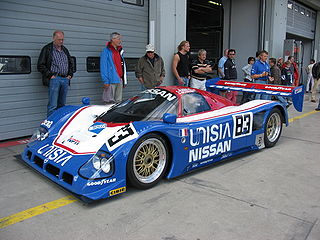
The Nissan R90C was a platform used for Group C racing cars built in 1990 by Nissan Motors for competition in World Sportscar Championship (WSC) based in Europe and the All Japan Sports Prototype Championship (JSPC). The cars based on the basic R90C platform would compete until 1993 before Nissan chose to withdraw from sports car racing, not returning until 1997. It won three JSPC championships and several significant endurance races during its career.
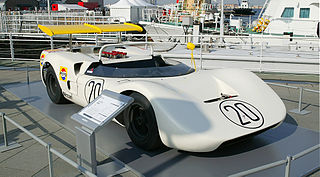
The Nissan R381 was a racing car developed by Nissan Motors in 1968 for use in the Japanese Grand Prix. It was the successor to the Nissan R380-II, which had been originally developed by the Prince Motor Company

The Toyota 7 was a series of racing cars developed by Toyota Motor Company in cooperation with Yamaha Motor Corporation. Designed primarily for use in FIA Group 7 competition, it was Toyota's first purpose-built racing car project.

The McLaren M6A was a Group 7 prototype race car designed and developed by driver Bruce McLaren, and built by his Bruce McLaren Motor Racing team for their entry in 1967 Can-Am season. As a replacement for the team's M1Bs from 1966, the Chevrolet-powered M6A's improved design earned Bruce McLaren and his team their first of multiple Can-Am championships. After the M6As were replaced by the M8A in preparation for 1968, McLaren and technical partner Trojan–Tauranac Racing developed the M6B which was sold to customers for use in Can-Am as well as other racing series.

The McLaren M20 was a sports prototype developed by McLaren for the 1972 season of the Canadian-American Challenge Cup. It served as a replacement for the team's M8Fs, but it later became the final Can-Am design created by McLaren before the team left the series after failing to secure the 1972 championship title. M20s continued to be entered by private teams until the Can-Am championship was canceled at the conclusion of the 1974 season. McLaren driver Denny Hulme won two races during the 1972 season while Scooter Patrick won a single event in 1974 with a privately entered M20.
The McLaren LT170 was a sports prototype racing car, built in 1971. The LT170 was a hybrid of the Lola T70 and McLaren M6B Can-Am cars, and used a Chevrolet V8 engine. One car was built, which Howie Sangster used on the way to winning the 1972 Western Australia Sports Car Championship.

The ATS D6 was a Formula One racing car manufactured and raced by the Team ATS during the 1983 Formula One season. It was powered by the BMW M12/13 4-cylinder turbocharged engine but the team failed to score any points.

The McLaren M8A was a race car developed by driver Bruce McLaren and his Bruce McLaren Motor Racing team for their entry in 1968 Can-Am season. The M8A and its successors dominated Can-Am racing for four consecutive Can-Am seasons, until the arrival of the Porsche 917.
The Surtees TS5 was a Formula 5000 racing car, designed, developed, and built by Surtees between 1969 and 1970.















